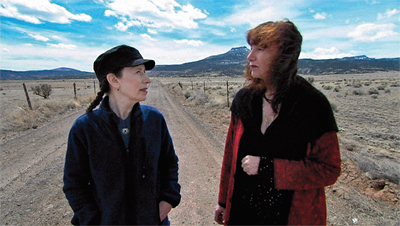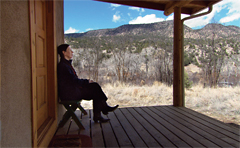
Listen to the podcast here.
“I always thought that America would be the one to start this,” says the Dutch filmmaker and media artist Babeth VanLoo. “This” is the first, and to date only, independent broadcast channel in the West airing Buddhist programs via a country’s public broadcasting system. Today, a decade after BOS—Boeddhistische Omroep Stichting, or the Buddhist Broadcast Foundation—was set up in the Netherlands, the United States still has not picked up on the idea.
Based in Hilversum, a town near Amsterdam that is the country’s media hub, BOS officially went on the air in January 2001. Scheduled into its one-hour weekly broadcast slot are 30- and 60-minute films covering dharma teachings and teachers, as well as Buddhism’s interface with the wider culture. (BOS also broadcasts over the Internet and carries radio programs and the youth-centered BodhiTV in Dutch.) For VanLoo, a cofounder of BOS and its programming director, the channel’s most important role is not to present films about Buddha-dharma but rather those “made in the spirit of Buddhism” by filmmakers who are themselves practitioners. She calls this “deep television”—reflective programs that “give time to a story” and offer viewers an immediate, even transforming experience as an alternative to the shallow, escapist “infotainment” that dominates mainstream media in Europe and the U.S.
A striking redhead who looks years younger than her age—she’s 61—Van- Loo arrived at the Tricycle office last March wearing a stylish black skirt and black-and-silver twinset—and cowboy boots. This wink at convention seems perfectly in character once she unwinds the narrative thread of her life. Although Buddhism is now seamlessly woven into VanLoo’s professional as well as personal biography, it was film that captured her attention first.
Raised in Maastricht, a city at the southernmost tip of the Netherlands, near the Belgian and German borders, VanLoo left home at 17 to study architecture, then art, in Germany. At the Dusseldorf Academy of Art she studied “social sculpture” with Joseph Beuys, an influential avant-garde artist who viewed art as inseparable from everyday life—and as a vehicle for transforming society. Beuys remained a major force in VanLoo’s work even after she moved to the U.S. to continue her studies: he was the subject of her first films of note, made while and after she earned a master’s degree in film and fine arts from the San Francisco Art Institute.
San Francisco in the 1970s was a fertile place for the arts. VanLoo was making 16 mm art films and videos on artists and musicians, and experimenting with multiscreen installations with live music. (The one wild card in her list of credits is a film on Arnold Schwarzenegger, shot while he was training for the Mr. Universe contest. “It was about making your body into an artwork,” VanLoo explains. Her husband at the time, Raymond Mondini, an American art history and world studies professor, interviewed the body builder.)
VanLoo met her first Buddhist teacher—Dilgo Khyentse Rinpoche— in 1976, in New York. Though she “had a feeling of coming home,” it was several years before she began daily practice. In San Francisco, she attended teachings by Dudjom Rinpoche. “At the time I was really into sex, drugs, and rock ’n’ roll, so it was also kind of a lifesaving thing,” VanLoo recalls. “I was so lucky to come into Dzogchen [Great Perfection] teachings, because it’s the path of liberation,” she adds. “I think it kind of fits with an artist’s mind to have a Dzogchen lineage.” (Dilgo Khyentse once described Dzogchen practice as “a complete carefree acceptance, an openness to all situations without limit.”)
When VanLoo moved back to Holland in the early 1980s, she continued to practice, rising at dawn to meditate before her children woke. Her daughter, Isadora, now 23, and son, Kimo, 27, “were schlepped to every retreat I went to when they were little,” she says, “but of course now they don’t want to have anything to do with Buddhism.”

Meredith Monk – Inner Voice. Courtesy Babeth VanLoo
Today, VanLoo sits retreats with the Dzogchen master Namkhai Norbu at his center in Merigar, Italy, and with Dzigar Kongtrul Rinpoche, Pema Chödrön’s teacher. She has done Madhyamaka training with Dzigar Kongtrul and Dzongsar Khyentse Rinpoche, the Bhutanese lama also known as Khyentse Norbu, who directed the films The Cup andTravellers and Magicians. “I’m blessed to have had two grand masters, Dilgo Khyentse and Dudjom Rinpoche—and Namkhai Norbu too,” VanLoo says. “But to have these young guys who are not born in Tibet [who have] such great mind and heart, that’s fantastic.” Recently, she has also been following Khandro Rinpoche: “She is very good, very sharp, a wonderful teacher.”
In 1989, VanLoo made her first Buddhist film, focused on Dilgo Khyentse and the reincarnation rituals following Dudjom Rinpoche’s death. Since then, she has filmed His Holiness the Dalai Lama and any number of Buddhist teachers—including Sakya Trizin, Sogyal Rinpoche, Lama Pema Wangyal, S. N. Goenka, and Matthieu Ricard— and has served as commissioning editor or producer for films featuring many more, including Joseph Goldstein, Sharon Salzberg, Thich Nhat Hanh, Stephen Batchelor, Jon Kabat-Zinn, Noah Levine, and Sayadaw U Kovida, a Burmese monastery abbot jailed for refusing gifts from the military. About 85 per cent of BOS programs are either in-house productions funded by the Netherlands Ministry of Education, Culture, and Science, or international coproductions; the rest are acquisitions.
It took a “huge collective effort”— including a lawsuit by the Buddhist Union of the Netherlands, a coalition of Buddhist groups—to make way for BOS. Dutch law grants media access to all religious minorities, but although Muslims and Jews each had a channel, for seven years the Buddhist Union’s application was denied on the grounds that Buddhism was just an Eastern religion. In court, the Union successfully argued that Buddhism was not only a religion but also a practice that could be a positive force in Western society.
BOS’s role as the public media platform for Buddhism is a responsibility VanLoo takes seriously. It’s important to present only “authentic teachers,” she says, and not to be sectarian or dogmatic. The channel’s guiding principles are the Buddhist paramitas, or perfections—generosity, discipline, patience, exertion, meditation, and insight—redefined for contemporary life. (Generosity, for example, in BOS terms includes “giving a voice to the oppressed and those in need.”)
“My teacher Beuys used to say that art starts with the mental sculpture— with the idea,” VanLoo says. Capturing the essence of the artistic process on film was the challenge behind her latest project, Meredith Monk – Inner Voice, an 82-minute documentary about the choreographer/composer/performance artist—and practicing Buddhist. “Meredith’s work really is that art is life, life is art—and also practice—so the nonboundaries between them are reflected in the film,” VanLoo notes. “I tried to make visible the interdependence of her life.” Inner Voice follows Monk on a concert tour and as she develops her latest piece, “Songs of Ascension.” It is an intimate film, showing the artist as she conceives a work in solitude, shapes it with her ensemble, and then performs it. In true Buddhist fashion, a Monk piece is always evolving. “Even at the performance stage she continues to transform her work, seeking a balance between discipline and freedom,” Van- Loo says. “It’s the Buddhist principle of constant change.”
In the film, Monk explains that she performs “in a state that’s quite close to meditation… very open and fluid to what’s happening in the moment.” Zen teacher and poet Norman Fischer gave her the idea for “Songs of Ascension” when he told her about the “Songs of Ascents”—15 psalms that, by varying accounts, were sung by the ancient Jews when they climbed the mountain (or temple steps) to worship. The theme of ascent inspired her to perform the piece inside artist Ann Hamilton’s Tower, an eight-story cement installation on art patron Steve Oliver’s ranch in northern California. The cylindrical tower contains two stairways entwined in a double helix: the audience stood along one stairway, the performers along the other.
Inner Voice provides a rare glimpse of Buddhist practice at work in an artist’s life. Monk’s “Scared Song” emerged from her experience of the Shambhala Level II training on fear and fearlessness. The death of Mieke van Hoek, Monk’s partner for 22 years, and the failing health of her 98-year-old mother, along with her own feelings of vulnerability after falling off a horse, all serve Monk— and vicariously, the film’s viewers—as teachings on impermanence. (Not incidentally, that is also the theme of Monk’s latest album,impermanence.)
VanLoo’s association with Monk dates back to the early 1990s, when they were neighbors in downtown New York. After BOS started up, the two reconnected and hatched the idea of collaborating on a film. The intention behind Inner Voice parallels Monk’s intention in her work—to provide an “alternative experience” for audiences. In the ’80s, Monk says in the film, her pieces were “more apocalyptic”; now her aim is to open people to “using all their perceptions and having a different spectrum of feeling” so they may see things in a different way.
Like other films aired on BOS, Inner Voice offers what VanLoo terms “a visionary approach to the crises we’re living through.” BOS is “looking at the big picture—not at symptoms, but really looking at the roots of things,” she explains, adding, “I think that is very valuable for audiences.” In Holland, viewers often gather in groups to watch the Buddhist channel together.
It’s just another expression of the interdependence theme that runs through BOS and, it would seem, VanLoo’s life. “As His Holiness always says, Buddhism is not just for Buddhists,” she notes. “All people can benefit from it.”
Thank you for subscribing to Tricycle! As a nonprofit, we depend on readers like you to keep Buddhist teachings and practices widely available.